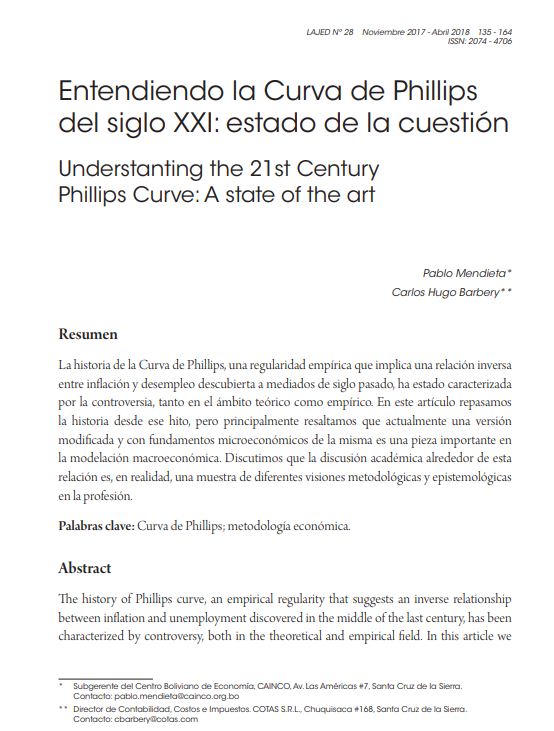Understanting the 21st Century Phillips Curve: A state of the art
DOI:
https://doi.org/10.35319/lajed.20172840Keywords:
Phillips curve, economic methodologyAbstract
The history of Phillips curve, an empirical regularity that suggests an inverse relationship between inflation and unemployment discovered in the middle of the last century, has been characterized by controversy, both in the theoretical and empirical field. In this article we review the history of this relationship, but mainly we emphasize that today a modified version with microeconomic foundations is an important piece in macroeconomic modeling. We argue that the academic discussion around this relationship is an example of different methodological and epistemological approaches in economics.
Downloads
References
Backhouse, R. 1998. Explorations in economic methodology. From Lakatos to empirical philosophy of science. Londres: Routledge.
Berg, A., P. Karam y D. Laxton. 2006. “A Practical Model-Based Approach to Monetary Policy Analysis-Overview”. IMF Working Papers.
Blaug, M. 1992. The methodology of economics or how economists explain (2a, ed.). Cambridge: Cambridge University Press.
Boug, P., A. Cappelen y A. Swensen. 2010. “The new Keynesian Phillips curve revisited”. Journal of Economic Dynamics & Control, 858-874.
Boylan, T. y P. O’Gorman. 2008. Popper and Economic Methodology. Contemporary Challenges. New York: Routledge.
Calvo, G. 1983. “Staggered Prices in a Utility-Maximizing Framework”. Journal of Monetary Economics, 383-398.
Cohn, S. 2007. Reintroducing Macroeconomics. A Critical Approach. New York: M. E. Sharpe.
D’Amato, L. y L. Garegnani. 2009. “ dinámica de corto plazo de la inflación: estimando una curva de Phillips híbrida neokeynesiana para la Argentina (1993-2007)”. Ensayos Económicos del BCRA, 33-56.
De-Gregorio, J. 2007. Macroeconomía. Teoría y Práctica. Santiago de Chile: Pearson Educación.
Dixit, A. y J. Stiglitz. 1977. “Monopolistic Competition and Optimum Product Diversity”. The American Economic Review, 297-308.
Fischer, S. 1977. “Long-term Contracts, Rational Expectations, and the Optimal Money Supply Rule”. Journal of Political Economy, 191-205.
Fondo Monetario Internacional. 1977. The Monetary Approach to the Balance of Payments, Exchange Rates, and World Inflation. Washington DC: Praeger.
---------- 2005. “How has globalization affected inflation?”. FMI, World Economic Outlook April (págs. 97-134). Washington DC: FMI.
---------- 2013. “The dog that didn’t bark: Has inflation been muzzled or was it just sleeping?” En F. M. Internacional, World Economic Outlook April (págs. 1-17). Washington DC: FMI.
Forder, J. 2014. Macroeconomics and the Phillips Curve Myth. Oxford: Oxford University Press.
Friedman, M. 1953. Essays in Positive Economics. Chicago: Chicago University Press.
Friedman, M. 1968. “The role of monetary policy”. The American Economic Review, 1-17.
Fuhrer, J. 1995. “The Phillips Curve is Alive and Well”. New England Economic Review, 41-56.
Gali, J. y M. Gertler. 1999. “Inflation dynamics: A structural econometric analysis”. Journal of Monetary Economics, 195-222.
Gali, J., M. Gertler y D. Lopez-Salido. 2005. “Robustness of the estimates of the hybrid New Keynesian Phillips ”. Journal of Monetary Economics, 1107-1118.
Granger, C. y Y. Jeon. 2011. “The Evolution of the Phillips Curve: A Modern Time Series Viewpoint”. Economica, 51-66.
Kuhn, T. 1970. The Structure of Scientific Revolutions. Chicago: Chicago University Press.
Lakatos, I. 1978. The Methodology of Scientific Research Programmes. Cambridge: Cambridge University Press.
Lipsey, R. 1960. “The relation between unemployment and the rate of change of money wage rates in the United Kingdom, 1882-1957: A further analysis”. Economica, 1-250.
Lucas, R. 1972. “Expectations and the Neutrality of Money”. Journal of Economic Theory, 103-124.
Maas, H. 2014. Economic Methodology. A historical introduction. New York: Routledge.
Maki, U. 2009. The Methodology of Positive Economics. Reflections on the Milton Friedman Legacy. Cambridge: Cambridge University Press.
McCallum, B. 1989. Monetary Economics. Theory and Policy. New York: Macmillan Publising Company.
Mendieta, P. y H.Rodriguez. 2007. “Una de Phillips neokeynesiana empírica para el caso de Bolivia”. Ponencia en la Primera Jornada de Modelación Económica de Bancos Centrales. Buenos Aires.
Murillo, A. 2014. Estimación de una curva de Phillips neokeynesiana para Bolivia”. Documento de trabajo del Banco Central de Bolivia.
Okun, A. 1962. “Potential GNP: Its Measurement and Significance”. En A. S. Association, Proceedings of the Business and Economics Statistics Section (págs. 98-104). Washington DC: American Statistical Association.
Parkin, M. 2009. Economia. México: Pearson Educación.
Phelps, E. 1967. “Expectations of Inflation and Optimal Unemployment over Time”. Economica, 254-281.
Phillips, W. 1958. “The Relation Between Unemployment and the Rate”. Econometrica, 283-299.
Pincheira, P. y H. Rubio. 2010. “El escaso poder predictivo de simples curvas de Phillips en Chile: una evaluación en tiempo real”. Documentos de trabajo del Banco Central de Chile.
Rotember, J. y M. Woodford. 1997. “An Optimization-Based Econometric Framework for the Evaluation of Monetary Policy”. En B. Bernanke y J. Rotemberg, NBER Macroeconomics Annual (pp. 297-346), Cambridge: The MIT Press.
Rotemberg, J. 1982. “Sticky Prices in the United States”. Journal of Political Economy, 1187-1211.
Samuelson, P. y W. Nordhaus. 2010. Economia con aplicaciones a Latinoamérica. México: McGraw-Hill.
Samuelson, P. y R. Solow. 1960. “Analytical Aspects of Anti-Inflation Policy”. The American Economic Review, 177-194.
Snowdon, B. y H. Vane. 2002. An Encyclopedia of Macroeconomics. Northampton: Edward Elgar Publishing. Inc.
Stock, J. y M. Watson. 2009. “Phillips Curve Inflation Forecasts”. En J. Fuhrer, Y. Kodrzycki, J. Sneddon y G. Olivei, Understanding inflation and the implications for monetary policy : a Phillips curve retrospective (pp. 101-185). Cambridge MA: The MIT Press.
Szentmihályi, S. y B. Világi. 2015. “The Phillips curve - of thought and empirical evidence”. Financial and Economic Review, 5-38.
Taylor, J. 1979. “Staggered Wage Setting in a Macro Model”. American Economic Review, 108-113.
Valdivia, D. 2008. “¿Es importante la fijación de precios para entender la dinámica de la inflación en Bolivia?” Documento de trabajo sobre desarrollo de INESAD.
Wade, H. 1992. “Falsification, Situational Analysis and Scientific Research Programs: The Popperian Tradition in Economic Methodology”. En N. Marchi, Post-Popperian Methodology of Economics: Recovering Practice (pp. 19-53). Boston: Kluwer Academic Publisher.
Walsh, C. 2010. Monetary Theory and Policy (. ed.) Cambridge, MA: The MIT Press.






